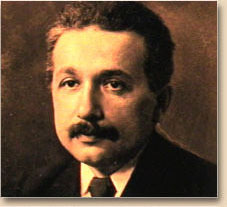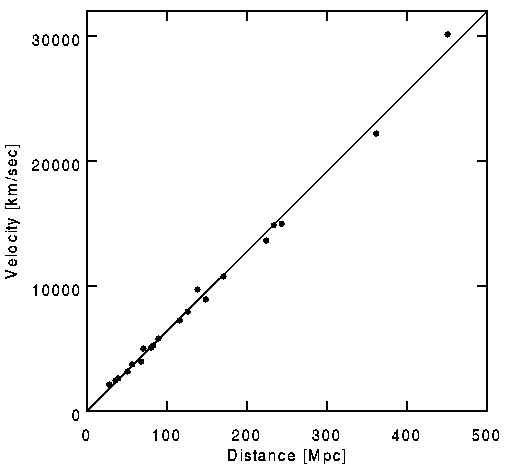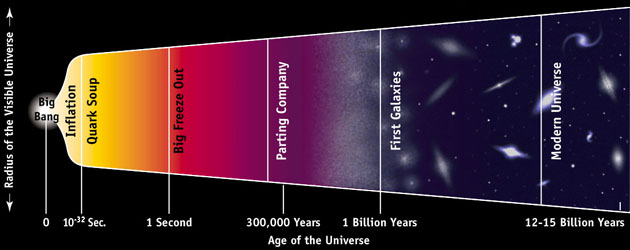
Steven Weinberg - a leading theoretical physicist and co-recipient of the 1979 Nobel Prize in Physics - cites "What could be more interesting than the problem of Genesis" as the main reason for writing his popular book "The First Three Minutes"
|
Cosmology: The Study of Genesis ... |

Steven Weinberg -
a leading theoretical physicist and co-recipient of the 1979
Nobel Prize in Physics - cites "What
could be more interesting than the problem of Genesis"
as the main reason for writing his popular
book "The First Three
Minutes"
Some of questions that we will attempt to answer are:
Olbers' Paradox and the Necessity of a Beginning
Olbers' paradox (1826) -- A look at the night sky suggests a changeless Universe, apart from local (small-scale) phenomena, such as the clouds drifting across the Moon. Hence, suppose that on large-scale the Universe is static, infinite, eternal, and uniformly filled with stars. Then one must reach the conclusion that every point on the night sky must be as bright as the surface of a star. The reason for this (seemingly crazy) conclusion is that the number of stars at any given distance increases with the square of the distance, while the intensity of light from a star decreases also with the square of the distance. In this way we should live in the center of a hollow blackbody whose temperature is (like that of the Sun) about 6000 degrees. This is Olbers' paradox, which can be traced as far back as Kepler in 1610, rediscussed by Halley and Cheseaux in the eighteen century, but was not popularized as a paradox until Olbers took up the issue in 1826. There are many possible explanations which have been considered. Here are a few:

Cosmological Principle:
On a large scale, the
Universe is Homogeneous and Isotropic. Moreover,
we believe in the Universality of the
Laws of Physics. To say that the Universe is homogeneous means
that any measurable property of the Universe is the same
irrespective of the position of the observer in the Universe.
The Isotropy of the Universe means that the Universe looks the
same in all directions. These statements are only
approximately correct at short distances (for example, for an
observer looking only at the Solar System) but they appear to
be an excellent approximation when one averages over very
large regions in space. That the laws of physics are universal
suggests that object, such as apples, obey the same laws here
on Earth than on any other celestial body. Thus, the
cosmological principle represents a large-scale generalization
of Copernicus viewpoint: We do not live in a special place in
the Universe. Indeed, all places in the Universe are equally
special. Note that accepting the Cosmological Principle,
simple as it may be, has important consequences:
Our
Universe
has no Center and no Edges.
The Expansion of the Universe:

In 1916 Albert Einstein published a new
theory of gravity called: "The
General Theory of Relativity".
The theory of GR predicted
that the Universe will either expand or contract depending on
the density of matter/energy within it. Yet, even Einstein did
not believe in some of the predictions of his own theory, such
as the idea of a dynamical Universe and, thus, constructed a
static model for the Universe. He called this one of the
biggest mistakes of his life!

In 1919 Sir Arthur Eddington, a leading British astronomer led an expedition to West Africa to study a solar eclipse and test one of the most important predictions of the newly developed Theory of General Relativity: The Bending of Light by the warping of spacetime near the Sun. Eddington through his observation confirmed Einstein's prediction and thus gave experimental basis to the General Theory of Relativity.

In 1922 Alexander Friedmann, a Russian mathematician, abandoned Einstein's model of a static Universe and taking into account the Cosmological principle constructed a model of an expanding universe. Friedmann proposed a model for a Dynamical Universe; recall that Einstein proposed that the size of the Universe was constant. Friedmann argued that space and time have to be homogeneous and isotropic - the Cosmological Principle - and that it should possible for the average density and radius of the universe to change over time. The Big-Bang Model developed from Friedmann's theory of an expanding Universe.

In 1929 Edwin Hubble discovered the velocity distance relation using the red-shift spectra of only 46 galaxies. Since then, Hubble's law has been confirmed for a large number of distant galaxies. Hubble's law is clear evidence that the Universe is expanding uniformly and has no center nor edges. Note that in the graph below the last point represents a galaxy located more than one billion light years away from Earth and receding at the colossal velocity of one tenth of the speed of light!

In retrospect, Hubble's
law is not that difficult to understand once we have adopted
the Cosmological Principle. Say three observers are located in
galaxies A, B, and C which are separated by equal amounts. If
B is receding away from A with a certain velocity "v", then,
by the Cosmological Principle, C must be receding from B at
the same exact speed v. This implies, by simply adding the
velocities, that C will be receding from A at twice the speed
(or 2v). This, of course, is Hubble's Law.

In 1965 Arno Penzias and Robert Wilson made
a monumental discovery. Like many of science's greatest
discoveries, the one that earned Penzias and Wilson the Nobel
Prize in 1978 was an event of pure serendipity. While tuning a
small, yet powerful and highly sensitive horn antenna for
conducting radio astronomy experiments, Penzias and Wilson
noted a constant low level noise disrupting their reception.
Despite their efforts, Penzias and Wilson could not find any
evidence of malfunction in their equipment. Moreover, the
static persisted regardless of the direction the antenna was
pointing. As they continued their investigation, Penzias and
Wilson came to realize that they indeed had stumbled onto the
most conclusive evidence to date supporting the Big Bang
Theory:
The Cosmic Microwave Background
(CMB).

The Cosmic Timeline

The Big Bang
Most scientists agree
that the Universe began some 12 to 15 billion years ago in
what has come to be known as the Big Bang; a term coined by the English astrophysicist
Fred Hoyle in 1950. Hoyle - who championed a rival
cosmological theory - meant the "Big Bang" to be a term of
derision, but the name was so catchy that it stuck. Though the
Big Bang suggests a colossal explosion, it wasn't really an
"explosion" in the sense that we understand it today, such as
the majestic Supernova explosions. At the precise instant of
the Big
Bang the
Universe was infinitely dense and unimaginably hot.
Cosmologists believe that all forms of matter and energy
packed into a space smaller than the atomic nucleus.
Yet, science tells us nothing about
the way space, time, and matter behaved in our
Universe's earliest instants, from the time of the Big Bang
all the way to 10-43 seconds later.

Immediately after the Big
Bang, spacetime was certainly expanding. Indeed very violently
and from this expansion of space was formed a highly energetic
soup of particles and antiparticles. Antiparticles are not the
result of science fiction - they are simple brothers and
sisters of the most commonly known particles, such as
electrons and quarks. For example, the antiparticle of the
electron is called the positron. It looks almost identical to
the electron except that it has opposite electric charge.
Physicists have constructed a family of fundamental
particles, divided into two groups
of quarks and leptons. Quarks are the building blocks of protons and
neutrons. Electrons, the most familiar lepton, combines with
protons and neutrons to form atomic nuclei. Also in the lepton
class are wispy, nearly massless neutrinos that
interact only very weakly with other particles. Elusive as
they are, neutrinos are abundant in the Universe and may be
(???????) dark-matter candidates. At about 10-12
seconds, quarks, leptons and their antiparticles (such as
antiquarks and positrons) were constantly colliding and
annihilating each other with a release of energy in the form
of photons. Likewise, two colliding photons could create
matter/antimatter. At this time, matter, antimatter, and photons
existed in equilibrium and in nearly equal amounts. There is hardly
any antimatter left in our observable Universe today - and a
good thing too or we wouldn't exist today as everything would
have been annihilated long ago! What happened to it? This is a fundamental question that is still
under debate.

Almost all of the Deuterium (Hydrogen with an
extra neutron), Helium, and some of the Lithium nuclei in our Universe today were created
during the "Era of Nucleosynthesis" which began about
1 second after the Big Bang and ended just 100 seconds later.
Note that Hydrogen nuclei did not have to be created; they
already existed in the form of the three-quark clusters we now
call protons.
One hundred seconds after the Big Bang the temperature dropped
to the point where protons and neutrons could stick together
without being torn apart by the highly energetic photons. This
condition, a mere one billion degrees, were suddenly ripe for
the formation of nuclei, the most stable of the lighter ones
being that having two protons and two neutrons: Helium.
At the end of the nucleosynthesis period, all of the neutrons
had paired with protons to form helium, 24% of the
primordial light elements and trace amounts of
Deuterium, Tritium (Hydrogen with two extra neutrons), Helium3
and Lithium. The protons left over made up the
remaining 75% of the Baryonic Matter. Scientists
believe that 98% of the Helium present in the Universe today
was produced - not in stars but - in those first few
seconds.

During the next 300,000 years very little happens. For 300,000 years, protons and atomic nuclei continued to roam the Universe in a almost totally opaque sea of photons, electrons and neutrinos; opaque because photons couldn't travel far without bumping into a charged particle. Indeed, any electron that combined with a proton or with an atomic nucleus was immediately knocked out by an energetic traveling photon. Matter and radiation were intimately linked. But after 300,000 years, the opaque soup of nuclear matter and radiation began to clear. The temperature of the Universe dropped to a cozy 3,000 K (one half of the temperature at the surface of the Sun). At this temperature, photons are no longer energetically enough to knock out electrons from atomic nuclei. Now the photons were free to travel through the Universe at last decoupled from matter. This Recombination Era lasted about one million years. The vast sea of photons created during the Big Bang persist to this day, in the form of Cosmic Microwave Background (CMB) that pervades the Universe. No longer widely energetic after being stretched by the expansion of the universe for roughly 15 billion years, this radiation has cooled to a chilly 2.73 K (minus 270.43 Celsius!). The CMB is considered by cosmologists to be one of the clearest and unavoidable signatures of the Big Bang.

Tiny variations in the
CMB have recently been found by the COBE
satellite in this background
radiation, indicating minute fluctuations in the density of
matter and energy at the time of recombination. These
fluctuations were eventually amplified by gravity to form the
objects which make up our Universe, such as Stars,
Galaxies,
Clusters and Superclusters of Galaxies.

Accompanying those minute fluctuations in radiation were also tiny fluctuations of baryonic matter (mainly Hydrogen and Helium). Gravitational attraction between the atoms concentrated them into faint clouds of gas. As the Universe expanded the surrounding matter gradually thinned out with the result that the internal gravity of the gas clouds grew relatively stronger. Slowly, but then faster and faster, the clouds pulled in more and more material from the surrounding medium. Eventually, the clouds began to collapse under their own gravity, evolving into galaxies. About one billion years after the Big Bang, the first galaxies and the stars they contain were born. Our own Milky Way galaxy was formed when the Universe was about 3 billion years old. It started as a huge sphere of gas. Some stars formed in globular clusters scattered in a sphere. This is now the halo of our galaxy. The rest of the gas settled into a disk around its central bulge and spiral arms formed.

The Big Bang has been enormously successful in explaining several properties of the observable Universe:
| Stage | Time | Temperature (Energy) | Description |
| First | 10-45 to 10-32 sec | Greater than 1015 K (100 GeV) | Inflation; generation of density fluctuations |
| Second | 10-6 sec | Greater than 1012 K (100 MeV) | Quark Soup (QG Plasma) |
| Third | 10-4 sec to 3 min | 1012 to 109 K (0.1 MeV) | Nucleosynthesis; formation of D, He and Li |
| Fourth | 400,000 years | 4,000 K (1 eV) | Formation of neutral atoms; radiation decouples |
| Fifth | 1 billion years | 20-3 K (1 meV) | Formation of first-generation stars and galaxies |
| Sixth | 3 billion years | 20-3 K (1 meV) | Formation of heavy elements by
supernovae; Formation of second-generations stars. |
| Seventh | 3-15 billion years | 3 K (0.25 meV) | Genesis of planets and LIFE |
Yet, not all is well in the Big Bang. For example, there is strong evidence that shortly after the Big Bang the Universe was essentially uniform in its density and appearance. When we peer out to the cosmos today, it's evident that the distribution of matter is far from uniform. In fact it's positively lumpy, even on a large scale, and clearly exhibits a hierarchical organization. As far as we can tell, planets formed sometime during starbirth, giving rise to solar systems such our own. Stars are organized into galaxies, which in turn appear to be bound gravitationally together in clusters. Superclusters of galaxies stretch across hundreds of billions of light years, bounded by enormous voids. How can this evident "lumpiness" be explained? That's but one of the questions challenging cosmologists as they try to explain the Universe we observe today. Other difficult questions about cosmic origins and evolution preoccupy their minds, such as: